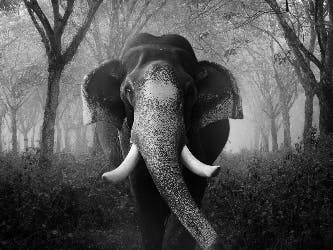It will be an understatement to say that the forests are being cut down for cultivation purposes because deforestation is being done at such a pace. The ramifications of these events are way too severe of which wildlife losing their home is a major component. As a result, many species have gone extinct and many others are endangered. It is said that if things keep going at the same pace and if no measures for conservation will be taken, Asian Elephants will be extinct by 2030. For this reason, this project aims to help conserve these beautiful creatures without human intervention and monitoring.
This project aims at real time monitoring of routine activities performed by elephants with minimal human intervention by using accelerometer sensor placed in the collars. This way if an anomaly is observed like increase in resting time or decrease in bathing time, we can estimate that the elephant needs medical care and thus can be provided in a much shorter time frame. Apart from accelerometer data, historical gps co-ordinates are also taken into account from the gps sensor placed in the collar. Based on these locations, we can estimate the habitat preference of elephants both individual animal and in general which could further help in mitigating human elephant conflict.
Solitis et. al. in their paper titled "Using simple algorithms, accelerometers identify activity budgets and bodyorientation in African elephants Loxodonta africana" have pointed out that for classifying routine activities, only dynamic acceleration from raw acceleration values is enough. Hence, for the data simulation part, we took mean and standard deviation of the dynamic acceleration for all three axes from this paper and randomly sampled from a gaussian normal distribution. The classes taken into account are "Bathing", "Swaying", "Feeding" and "Walking". We generated 100,000 samples of each class for training and 10,000 samples of each class for testing. The generated data is collected at frequency of 10Hz.
The generated model achieves 100% training and testing accuracy and this is not the case of overfitting as the data itself is very easily separable as a result of dynamic acceleration extraction. This can be seen in the image below.
For the deployment part, due to lack of hardware component and on field data, we downloaded the tflite file and used it to classify simulated data. We plotted the incoming acceleration values on a dynamic chart created in javascript on a webpage and show the classification above it. Other than this, we took historical gps data from movebank.org and plotted the heatmap of 10 elephants in study both for each individual elephant and all of them together. Map plotting is also done in javascript using leaflet.js.
From the back-end, the data comes continuously as will be the case in real scenario and a dynamic chart is rendered every time new data comes and the real time classification prediction is shown on the top of the chart. The visualization can be seen in the video below.
https://drive.google.com/file/d/1xDzEbqxr5medtkGUYmECNxso2Rm_dOF5/view?usp=sharing
The heatmap clearly shows the affinity of elephants towards natural water source(river).




Comments
Please log in or sign up to comment.